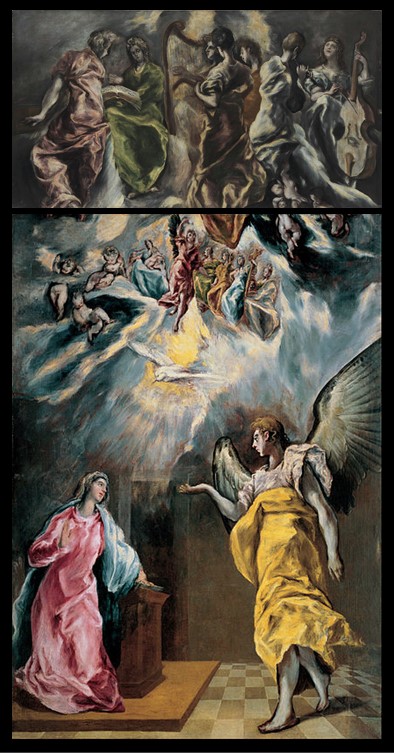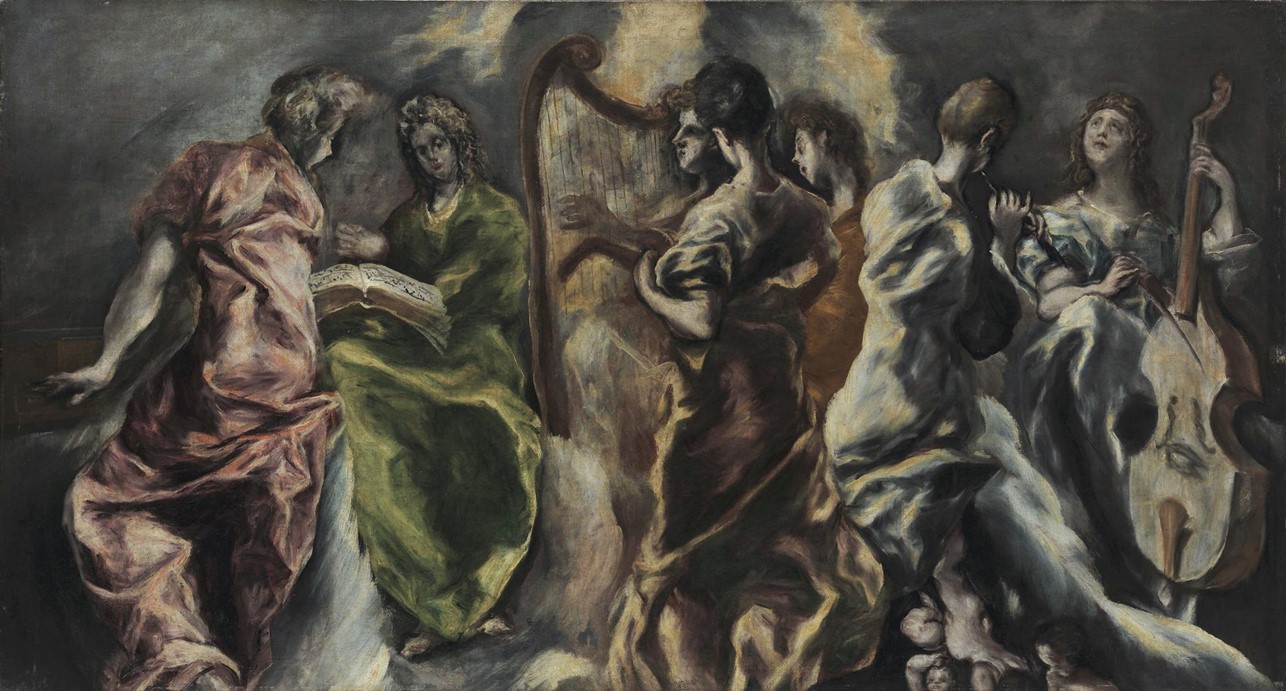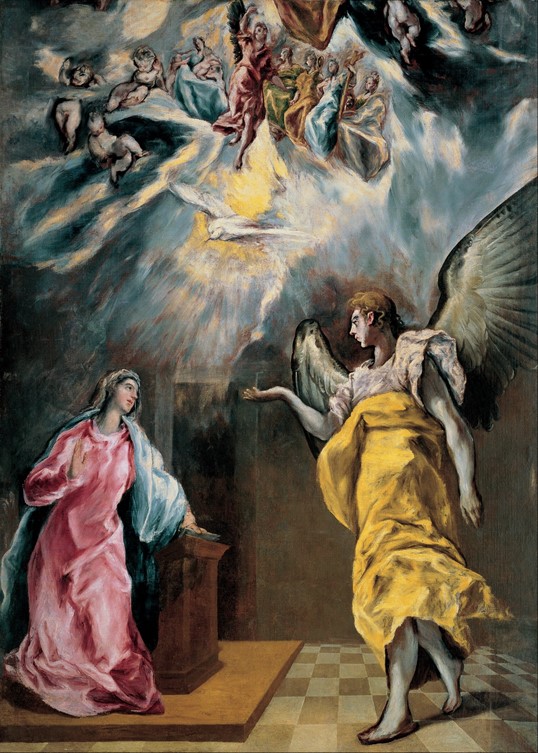
The Concert of the Angels, c. 1608-1614, oil on canvas, 115-217 cm, National Gallery – Alexandros Soutsos Museum – Evripidis Koutlidis Foundation, Athens https://www.nationalgallery.gr/en/painting-permanent-exhibition/painting/domenicos-theotokopoulos-el-greco/the-concert-of-the-angels.html
Together with…
The Annunciation, 1614, oil on canvas, 2.940,00×2.090,00 mm, Banco Santander, Spain
https://el.m.wikipedia.org/wiki/%CE%91%CF%81%CF%87%CE%B5%CE%AF%CE%BF:Domenikos_Theotokopoulos,_El_Greco_-_The_Annunciation_-_Google_Art_Project.jpg
Domenicos Theotokopoulos is in my heart. I find him an attractive personality in every aspect… talented, educated, ambitious, curious, adventurous, persistent… “Art is everywhere you look for it, hail the twinkling stars for they are God’s careless splatters…” he wrote and I think of his Angelic Musicians, shining like flickering stars, in the National Gallery in Athens. http://elgreco.net/el-greco-quotes.jsp and https://www.nationalgallery.gr/en/painting-permanent-exhibition/painting/domenicos-theotokopoulos-el-greco/the-concert-of-the-angels.html
Domenicos Theotokopoulos was a Cretan Greek, born in Handaka-Candia, present-day Herakleion, part, at the time, of the thriving Republic of Venice. Archival research in Venice showed that between 1526-28 his family relocated from Chania to Handaka where in 1541 Domenicos was born. His orthodox-Greek family belonged to the upper-middle class, as his father, Giorgos Theotokopoulos, worked for the government of the Venetian Republic, most probably as a merchant and a tax collector. Very little is known of Domenicos’s mother and early childhood. He was undoubtedly talented, and his father, realizing it, placed him as an apprentice in a painter’s workshop to learn this profitable trade. The name of his teacher is unknown, but judging from Domenicos’s earliest paintings, he was a great master of the Post-Byzantine Cretan School. Crete at the time was the center of a thriving artistic community and understanding the artist’s early influences and style is important in decoding his later work! https://www.historical-museum.gr/webapps/elgreco/xronologio.php?lang=en
By 1567/8 Theotokopoulos travelled to Venice, by 1570, he was in Rome, by 1576 he moved to Spain and in 1577 the artist settled in Toledo, where he found his spiritual home and remained for the rest of his life. He died on the 7th of April 1614, admired for his unique fluid style, temperamental character and humanist education. One of his friends and admirers, Hortensio Félix Paravicino y Arteaga (1580-1633) the Spanish poet, preacher and a member of the Trinitarian Order, wrote for the artist “O Greek divine! We wonder not that in thy works / The imagery surpasses actual being.” Paravicino also wrote, foreseeing Theotokopoulos’s legacy “Future generations will admire his strange genius, but for centuries he will not be imitated.” http://www.nccsc.net/essays/spanish-style
I would like the reader of this BLOG POST, titled Angelic Musicians, to focus on two paintings. One of them is in Athens and is titled The Concert of the Angels, the other is in Madrid, and is an Annunciation scene. Now imagine them together and you will see one of the last, if not the last painting, the artist created but never finished. The original painting, an Annunciation scene, was commissioned for the Chapel of the Hospital of St. John the Baptist outside the walls of Toledo. Today, separated, the product of 19h century vandalism, may look slightly odd, but still, enthral the viewer with their unique “beauty.”

The Concert of the Angels, c. 1608-1614, oil on canvas, 115-217 cm, National Gallery – Alexandros Soutsos Museum – Evripidis Koutlidis Foundation, Athens
https://www.nationalgallery.gr/en/painting-permanent-exhibition/painting/domenicos-theotokopoulos-el-greco/the-concert-of-the-angels.html
The Concert of the Angels in Athens is for me a wonderful depiction of an imaginary, celestial concert, full of energy and vibrato. Domenicos Theotokopoulos, the so-called El Greco, loved music and treated it with respect. The painting in Athens shows a musical ensemble with seven “ecstatic” angels, reading music, singing or playing the spinet, a harp, a flute and a viola da gamba. I wonder what kind of music Domenico enjoyed most, and which musician of his time he favoured… https://www.nationalgallery.gr/en/painting-permanent-exhibition/painting/domenicos-theotokopoulos-el-greco/the-concert-of-the-angels.html
The artist uses swift brushwork and swaying movement in postures and robes to create excitement in his composition. Like tongues of fire, his swirling figures look more like spiritual beings than real bodies…
The colour palette that the artist uses is another distinctive characteristic of his mannerism. The colours are iridescent but bold. He uses oranges in red and green and yellow/gold in blue. Tints and shades are juxtaposed. Values of high or low intensity are treasured. Theotokopoulos’s final Annunciation was never finished but whether you see its upper part in Athens or the actual Annunciation part in Madrid, its expressive power is unquestionable.
For a PowerPoint on Theotokopoulos’s paintings of the Annunciation, please … Click. HERE!
The National Gallery – Alexandros Soutsos Museum – Evripidis Koutlidis Foundation in Athens has uploaded a wonderful (in Greek) Video to watch… https://www.facebook.com/watch/?v=316373302403183

The Annunciation, 1614, oil on canvas, 2.940,00×2.090,00 mm, Banco Santander, Spain
https://el.m.wikipedia.org/wiki/%CE%91%CF%81%CF%87%CE%B5%CE%AF%CE%BF:Domenikos_Theotokopoulos,_El_Greco_-_The_Annunciation_-_Google_Art_Project.jpg